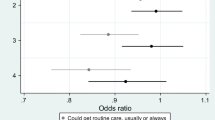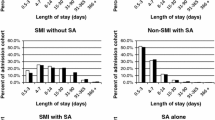Abstract
Long waits for health care are hypothesized to cause negative health outcomes due to delays in diagnosis and treatment. This study uses administrative data to examine the relationship between time spent waiting for outpatient care and the risk of hospitalization for an ambulatory care sensitive condition (ACSC). Data on the number of days until the next available appointment were extracted from Veterans Affairs (VA) medical centers. Two methodological issues arose. First, the simultaneous determination of individual health status and wait times due to medical triage was overcome by developing an exogenous wait time measure. Second, selection bias due to unobserved case mix differences was minimized by separating in time the sample selection period from the period when wait times and outcomes were measured. Exogenous facility-level wait time was the main variable of interest in a fixed effects stacked heteroskedastic probit regression model that predicted the probability of ACSC hospitalization in each month of a six-month period. There was a significant and positive relationship between facility-level wait times and the probability of experiencing an ACSC hospitalization, especially for facility-level wait times of 29 days or more. Further research is needed to replicate these findings in other populations and among those with different clinical histories. As well, policymakers and researchers need an improved understanding of the causes of long wait times and interventions to decrease wait times.
Similar content being viewed by others
Notes
Hospitalizations that potentially could have been prevented through appropriate outpatient care have been referred to as “ambulatory care sensitive,” “preventable,” “avoidable,” or “prevention quality indicators” (AHRQ 2001; Culler et al. 1998). We use the term ACSC hospitalization throughout this article.
The wait time measure is based on next available appointments versus follow-up appointments that may be scheduled in advance. This may reduce the impact of waiting time on health outcomes. However, patients cannot request follow-up appointments until the doctor has requested to see them again. Our wait time measure based on next available appointments is an overall measure of congestion at different VA facilities and both newly requested and follow-up appointments at facilities with greater congestion will be delayed. Furthermore, patients who need to reschedule follow-up visits or who have complications between follow-up visits will require next available appointments and rely on the appointment type our wait time measure is based on.
For ease of presentation, “facility” and “parent station” are used interchangeably throughout the article to refer to a VA parent station.
Only 37% of the clinic visits in the entire sample were to a geriatric outpatient clinic. Thus, the sample used a wide range of health care services beyond geriatric outpatient clinics.
In the final sample, 12% of the clinic appointments were imputed with 0.
The standard correction for selection bias involves estimating a first stage selection model and explicitly accounting for the expected value of the disturbance term from that model in the second stage equation of interest. Because we do not have veterans in our sample who chose not to come to a VA medical center for care, we cannot take this approach.
Our previous work examining the relationship between wait times and mortality included the same explanatory variables to risk-adjust for prior individual health status presented in this article. However, the mortality models also included whether or not a patient had a 50% or more service-connected disability (e.g. a condition or disability that the VA has determined was incurred or aggravated by military service). In models predicting ACSC hospitalization, service-connected disability had no significant effect. It was excluded in the final models because of the loss of observations due to missing values on service-connected disability.
References
Baar, B.: New patient montitor: data definitions. Veteran Health Administration Support Services Center (2005a)
Baar, B.: Next available detail data: Data definitions. Veterans Health Administration Support Services Center (2005b)
Berlowitz, D.R., Brandeis, G.H., Anderson, J., Du, W., Brand, H.: Effect of pressure ulcers on the survival of long-term care residents. J. Gerontol. A Biol. Sci. Med. Sci. 52(2), M106–M10 (1997)
Charlson, M.E., Pompei, P., Ales, K.L., MacKenzie, C.R.: A new method of classifying prognostic comorbidity in longitudinal studies: development and validation. J. Chronic Dis. 40(5), 373–383 (1987)
Culler, S.D., Parchman, M.L., Przybylski, M.: Factors related to potentially preventable hospitalizations among elderly. Med. Care 36(6), 804–817 (1998)
Deyo, R.A., Cherkin, D.C., Ciol, M.A.: Adapting a clinical comorbidity index for use with ICD-9-CM administrative databases. J.Clin. Epidemiol. 45(6), 613–619 (1992)
Gordon, P., Chin, M.: Achieving a New Standard in Primary Care for Low-income Populations: Case Studies of Redesign and Change Through a Learning Collaborative. pp. 17. The Commonwealth Fund, New York (2004)
Greene, W.H.: Econometric Analysis, 2nd edn. Prentice Hall, Upper Saddle River (1993)
Institute of Medicine (IOM): The Committee on the Quality of Health Care in America, Crossing the Quality Chasm: A New Health System for the 21st Century. Institute of Medicine, Washington D.C. (2004)
Kenagy, J.W., Berwick, D.M., Shore, M.F.: Service quality in health Care. J. Am. Med. Assoc. 281(7), 661–65 (1999)
Mukamel, D.B., Spector, W.D.: Nursing home costs and risk-adjusted outcome measures of quality. Med. Care 38(1), 78–89 (2000)
Murray, M., Berwick, D.M.: Advanced access: reducing waiting and delays in primary care. J. Am. Med. Assoc. 289, 1035–40 (2003)
Murray, M., Bodenheimer, T., Rittenhouse, D., Grumbach, K.: Improving timely access to primary care: case studies of the advanced access model. J. Am. Med. Assoc. 289(8), 1042–46 (2003)
Porell, F., Caro, F.G., Silva, A., Monane, M.: A longitudinal analysis of nursing home outcomes. Health Serv. Res. 33(4), 835–65 (1998)
Prentice, J.C., Pizer, S.D.: Delayed access to health care and mortality. Health Serv. Res. 42(2), 644–662 (2007)
AHRQ: Quality indicators-guide to prevention quality indictors: hospital admission for ambulatory care sensitive conditions. Agency for Healthcare Research and Quality Rockville; AHRQ Pub No. 02-R0203 (2001)
Rosen, A., Wu, J., Chang, B.H., Berlowitz, D., Ash, A., Moskowitz, M.: Does diagnostic information contribute to predicting functional decline in long-term care? Med. Care 38(6), 647–59 (2000)
Selim, A.J., Berlowitz, D.R., Fincke, G., Rosen, A.K., Ren, X.S., Christiansen, C.L., Cong, Z., Lee, A., Kazis, L.: Risk-adjusted mortality rates as a potential outcome indicator for outpatient quality assessments. Medical Care 40(3), 237–45 (2002)
StataCorp. STATA (release 9.0) Statistical Software. StataCorp, College Station, TX (2005)
United States Government Accounting Office (U.S. GAO): More national action needed to reduce waiting times, but some clinics have made progress. United States General Accounting Office. GAO-01–953, (2001)
VanDeusen Lukas, C., Meterko, M., Mohr, D., Seibert, M.N.: The Implementation and Effectiveness of Advanced Clinic Access. Health Services Research and Development Management Decision and Research Center. Office of Research and Development, Department of Veteran Affairs, Boston (2004)
Veterans Health Administration (VHA): Decision support office, “summary of active stop codes; Reference I.,” Washington D.C., 2004. [accessed on January 15, 2005]. Available at http://vaww.dss.med.va.gov/programdocs/pd_oident.asp
Wilcox, S., Seddon, M., Dunn S., Edwards, R.T., Pearse, J., Tu, J.V.: Measuring and reducing waiting times: a cross-national comparison of strategies. Health Affairs 26(4), 1078–1087 (2007)
Acknowledgements
Salary support for Dr. Prentice was provided by a Health Services Research Fellowship from the Center for Health Quality, Outcomes and Economic Research in the Department of Veteran Affairs. Additional support was provided under Grant Nos. IIR-04-233-1 & IAD-06-112-3 from the Department of Veterans Affairs, Health Services Research & Development Service. The views expressed in this article are those of the authors and do not necessarily represent the position or policy of the Department of Veterans Affairs.
Author information
Authors and Affiliations
Corresponding author
Appendices
Appendix A
Example of exogenous wait time calculation*
Appointment type | October–March (Sample selection period) | July wait times | August wait times | ||||
|---|---|---|---|---|---|---|---|
Station 1 | Station 2 | Station 1 | Station 2 | Station 1 | Station 2 | ||
# of appointments | # of appointments | National proportion of appointments | Wait in days | Wait in days | Wait in days | Wait in days | |
Primary care | 18 | 13 | 0.37 | 20.8 | 36.5 | 15.2 | 34.2 |
Psychology | 8 | 13 | 0.25 | 33.2 | Missing | 20.9 | 10.0 |
Optometry | 12 | 10 | 0.26 | 25.5 | 27.4 | 23.8 | 28.4 |
Women’s clinic | 10 | – | 0.12 | 21.2 | – | 22.5 | – |
Wait time calculation | (0.37 × 20.8) + (0.25 × 33.2) + (0.26 × 25.5) + (0.12 × 21.2) = 25.17 | (0.41 × 36.5) + (0.29 × 00.0) + (0.30 × 27.4) = 23.19 | (0.37 × 15.2) + (0.25 × 33.2) + (0.26 × 25.5) + (0.12 × 21.2) = 20.02 | (0.41 × 34.2) + (0.29 × 10.0) + (0.30 × 28.4) = 25.44 | |||
Appendix B
Coefficients and P-values of a Fixed Effects Heteroskedastic Stacked Probit Model Predicting Hospitalizations Due to Trauma, 2001 (n = 187, 526 person months; 31,830 people)§
Independent variables | Coefficient | P value | Coefficient | P value |
|---|---|---|---|---|
Facility wait time in days–linear | 0.0023 | 0.499 | ||
Facility wait time in days (Ref = <22.5 days) | ||||
22.50–25.99 days | −0.0249 | 0.732 | ||
26.00–28.99 days | −0.0248 | 0.749 | ||
29.00–31.49 days | −0.0823 | 0.425 | ||
31.50–34.49 days | −0.0043 | 0.954 | ||
34.50–37.49 days | −0.0381 | 0.655 | ||
37.50–40.99 days | 0.1143 | 0.196 | ||
41.00–44.99 days | −0.0634 | 0.534 | ||
45.00–48.99 days | 0.0316 | 0.751 | ||
> = 49 days | 0.1419 | 0.378 | ||
Female (Ref = male) | 0.0660 | 0.371 | 0.0662 | 0.366 |
Age | 0.0150 | <0.001 | 0.0150 | <0.001 |
Charlson index | 0.0052 | 0.591 | 0.0051 | 0.596 |
Cancer (Ref = no)* | −0.1061 | 0.112 | −0.1061 | 0.106 |
Endocrine disease (Ref = no) | 0.0223 | 0.680 | 0.0212 | 0.693 |
Heart disease (Ref = no) | −0.0340 | 0.589 | −0.0332 | 0.592 |
Neurological disease (Ref = no) | 0.1079 | 0.047 | 0.1077 | 0.046 |
Psychiatric disease (Ref = no) | 0.0899 | 0.085 | 0.0907 | 0.082 |
Pulmonary disease (Ref = no) | −0.0202 | 0.718 | −0.0197 | 0.724 |
Sensory disease (Ref = no) | −0.0437 | 0.426 | −0.0434 | 0.429 |
Other disease (Ref = no) | 0.0735 | 0.232 | 0.0731 | 0.233 |
Number of disease categories | 0.0328 | 0.453 | 0.0325 | 0.455 |
Count of observations per person@ | 0.0107 | 0.250 | 0.0104 | 0.228 |
Number of observations per clinic divided by 10000 | −0.3254 | 0.126 | −0.3301 | 0.123 |
Likelihood ratio test of heteroskedacity | Likelihood ratio test of heteroskedacity | |||
χ2 = 2.34, degrees of freedom = 1; P = 0.126 | χ2 = 2.38, degrees of freedom = 1; P = 0.123 | |||
Rights and permissions
About this article
Cite this article
Prentice, J.C., Pizer, S.D. Waiting times and hospitalizations for ambulatory care sensitive conditions. Health Serv Outcomes Res Method 8, 1–18 (2008). https://doi.org/10.1007/s10742-007-0024-5
Received:
Revised:
Accepted:
Published:
Issue Date:
DOI: https://doi.org/10.1007/s10742-007-0024-5




